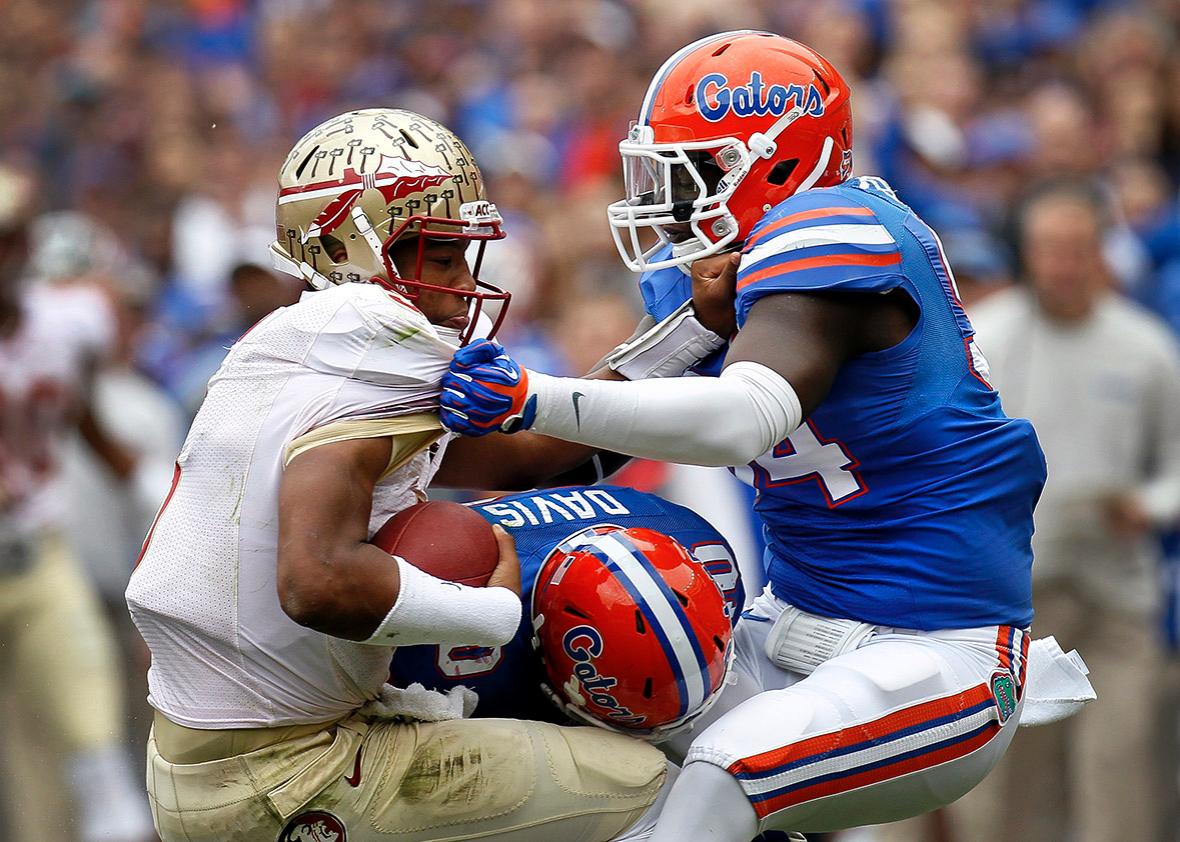The weekend after Thanksgiving is one of the biggest on the college football calendar: Rivalry Week. On Saturday, Auburn takes on Alabama, whose fans refer to their state rival as a “cow college” and to its supporters as barners. (The implication of the latter insult is that Auburn fans are often seen in and around barns.) UCLA squares off against its fellow Los Angelinos at USC, whose students are thought of by UCLA backers as “rich douches.” There’s a showdown between Ole Miss and Mississippi State, a matchup that Ole Miss partisans have been known to characterize as “culture vs. agriculture.” Florida State battles Florida in a rivalry that inspired Republican presidential candidate Marco Rubio to quip that he doesn’t have anything against Florida State because “there has to be a school where people that can’t get into Florida can go to college.” And of course there’s Michigan versus Ohio State—not an in-state rivalry, but arguably the most heated of the lot—which is said to pair Michigan arrogance against Ohio “hillbillies.”
You might be noticing a trend here: High-profile rivalry games—and especially in-state rivalries—are consistently perceived by fans to pit stuck-up twerps against doofus hicks. Why is this the case? Why do so many famous American college sports rivalries break down along lines that might be most succinctly described as slobs versus snobs? Two recent sociological studies—one of which was conducted by researchers who gathered the pejorative descriptors quoted above—might provide an answer when considered alongside a particular piece of 19th-century legislative history.
These studies, a 2010 Academy of Management Journal paper and a 2015 article in European Sport Management Quarterly, each identified so-called “antecedents” of athletic antagonism. Each study’s authors surveyed fans about who their teams’ rivals were. The first group of researchers then compared the results with objective data about the teams involved (distance between their stadiums, for example), while the other researchers asked a second group of fans to assign points to various rivalry characteristics based on the fans’ own feelings about what contributed to the rivalries they cared about. The 2010 paper found that rivalry was influenced by such factors as frequency of competition, competitiveness (i.e. each team having won close to half of past games), and geographic proximity. The 2015 article similarly cited the importance of frequent competition, proximity, and balanced competitiveness, but also identified cultural factors—both cultural similarities and cultural differences between groups of fans—as influential in rivalry creation.
It’s not hard to see how culture plays a part here. In sociological and psychological terms, human beings have a well-known tendency to think of ourselves as being part of “ingroups,” which we constantly compare to “outgroups.” And we like to think of ourselves as being both different from and superior to those other groups. As Joe Cobbs of Northern Kentucky University (who co-wrote the 2015 study with David Tyler of Western Carolina University) told me, our identities are threatened by outgroups that are very similar to our ingroups. People respond psychologically to this dynamic by “emphasizing the differences and minimizing the similarities” between, say, the good Mississippians at Mississippi State and the bad ones at Ole Miss. To put it another way, we engage in the narcissism of minor differences because we all want to be special snowflakes.
In this context, the United States’ system of higher education seems almost perfectly constructed to produce high-intensity sports rivalries. In 1862, Congress’ Morrill Land-Grant College Act set up a program that gave federal public land to individual states in exchange for agreements to set up universities that would specialize in “Agriculture and Mechanic Arts.” (“Public land” is a euphemism here for “stolen land,” but that’s another story.) These land-grant colleges—including, just to pick some random examples, Mississippi State, Auburn, and Ohio State—were often located in the vicinity of older, prestigious liberal arts schools. A few decades later, institutions of both types would be caught up in America’s football craze—which actually began on college campuses, launching the association between secondary education and big-time sports. Many close-together schools naturally settled into a habit of playing football every year, traditions that are now in some cases more than 100 years old.
Thus ingroup/outgroup relationships were created between groups of students who had a lot in common except for the fact that some of them were liberal arts scholars and the others went to what was originally a farm school. Is it any surprise that a number of rivalries evolved in which one side saw itself as smarter and more distinguished while the other side took pride in being the salt of the earth? In cases where the liberal arts/agriculture dichotomy isn’t in play, issues of condescension (and the resentment thereof) have still developed. Florida fans once looked down on Florida State because it had been a women’s school for several decades, while USC is a high-priced private institution that shares a city with UCLA, which is public. If you’re watching a Rivalry Week football game, there’s a good chance you are thinking—maybe consciously, maybe not—about your class status. Go team!
